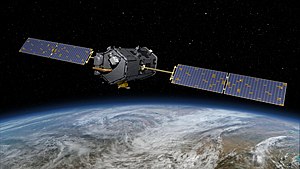OCO-2

Artist depiction of OCO-2
|
|
| Mission type | Climatology |
|---|---|
| Operator | NASA |
| COSPAR ID | 2014-035A |
| SATCAT № | 40059 |
| Website | oco.jpl.nasa.gov |
| Mission duration | Planned: 2 years Elapsed: 2 years, 6 months, 13 days |
| Spacecraft properties | |
| Bus | LEOStar-2 |
| Manufacturer | Orbital Sciences |
| Launch mass | 454 kg (1,001 lb) |
| Dry mass | 409 kg (902 lb) |
| Payload mass | 131 kg (289 lb) |
| Dimensions | Stowed: 2.12 × 0.94 m (6.96 × 3.08 ft) |
| Power | 815 W |
| Start of mission | |
| Launch date | 2 July 2014, 09:56:23 UTC |
| Rocket | Delta II 7320-10C |
| Launch site | Vandenberg SLC-2W |
| Contractor | United Launch Alliance |
| Orbital parameters | |
| Reference system | Geocentric |
| Regime | Sun-synchronous |
| Semi-major axis | 7,080.59 km (4,399.67 mi) |
| Eccentricity | 0.000191 |
| Perigee | 701.10 km (435.64 mi) |
| Apogee | 703.81 km (437.33 mi) |
| Inclination | 98.20° |
| Period | 98.82 minutes |
| RAAN | 202.67° |
| Argument of perigee | 86.95° |
| Mean anomaly | 273.19° |
| Mean motion | 14.57 rev/day |
| Velocity | 7.5 km/s (4.7 mi/s) |
| Epoch | 19 September 2016, 10:55:06 UTC |
| Revolution number | 11,796 |
| Main telescope | |
| Type | Near-IR Cassegrain (ƒ/1.8) |
| Wavelengths | 2.06 microns 1.61 microns 0.765 microns |
| Instruments | |
| 3 grated spectrometers | |
 |
|
Orbiting Carbon Observatory 2 (OCO-2) is an American environmental science satellite which launched on 2 July 2014. A NASA mission, it is a replacement for the Orbiting Carbon Observatory which was lost in a launch failure in 2009.
The OCO-2 satellite was built by Orbital Sciences Corporation, based around the LEOStar-2 bus. The spacecraft is being used to study carbon dioxide concentrations and distributions in the atmosphere.
OCO-2 was ordered after the original OCO spacecraft failed to achieve orbit. During the first satellite's launch atop a Taurus-XL in February 2009, the payload fairing failed to separate from around the spacecraft and the rocket did not have sufficient power to enter orbit with its additional mass. Although a Taurus launch was initially contracted for the reflight, the launch contract was cancelled after the same malfunction occurred on the launch of the Glory satellite two years later.
United Launch Alliance launched OCO-2 using a Delta II rocket at the beginning of a 30-second launch window at 09:56 UTC (2:56 PDT) on 2 July 2014. Flying in the 7320-10C configuration, the rocket launched from Space Launch Complex 2W at Vandenberg Air Force Base. The initial launch attempt on 1 July at 09:56:44 UTC was scrubbed at 46 seconds on the countdown clock due to a faulty valve on the water suppression system, used to flow water on the launch pad to dampen the acoustic energy during launch.
OCO-2 joined the A-train satellite constellation, becoming the sixth satellite in the group. Members of the A-train fly very close together in sun-synchronous orbit, to make nearly simultaneous measurements of Earth. A particularly short launch window of 30 seconds was necessary to achieve a proper position in the train. As of 19 September 2016 it was in an orbit with a perigee of 701.1 km (435.6 mi), an apogee of 703.8 km (437.3 mi) and a 98.2 degree inclination.
...
Wikipedia
